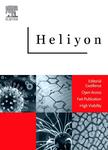版权所有:内蒙古大学图书馆 技术提供:维普资讯• 智图
内蒙古自治区呼和浩特市赛罕区大学西街235号 邮编: 010021

作者机构:Doctoral School of Environmental Science The Hungarian University of Agriculture and Life Sciences Páter Károly u. 1 Gödöllő 2100 Hungary Department of Earth Science Mbeya University of Science and Technology PO BOX 131 Mbeya Tanzania Institute of Geomatics and Civil Engineering Faculty of Forestry University of Sopron Bajcsy-Zsilinszky ut. 4 Sopron 9400 Hungary Department of Forest and Environment Faculty of Forest Science and Technology University of Gezira Wad Madani Sudan Institute of Aquatic Ecology Centre for Ecological Research Karolina str. 29. Budapest 1113 Hungary Faculty of Environmental Studies and Resources Development Chuka University P.O. Box 109 Chuka 60400 Kenya Humboldt Universität zu Berlin Faculty of Life Sciences Invalidenstraße 42 Berlin 10115 Germany Department of Geomatic Engineering and Geospatial Information Systems Jomo Kenyatta University of Agriculture and Technology P.O. Box 62000 Nairobi 00200 Kenya University of Augsburg Faculty of Applied Computer Sciences Institute of Geography Alter Postweg 118 Augsburg 86159 Germany
出 版 物:《Heliyon》 (Heliyon)
年 卷 期:2025年第11卷第2期
页 面:e41691页
主 题:Climate variability Geology Land use /land cover change Soda-saline lakes Soil type
摘 要:This study employed Remote Sensing and Geographical Information Systems to explore the influence of environmental factors and human-induced land use/land cover changes on the chemistry of soda-saline lakes in Northern Tanzania. Satellite-based rainfall data were sourced from the Climate Hazards Group Infrared Precipitation with Station (CHIRPS) datasets, and temperature data were obtained from MERRA-2. Monthly precipitation, temperature, and drought conditions in lake watersheds were analyzed from 1981 to 2022, while land use and land cover changes were assessed for 2000, 2014, and 2023. Soil types were acquired from the FAO Digital Soil Map of the World, while geological characteristics were sourced from the US Geological Survey database. The findings revealed that the region s climate is ideal for enhancing evapotranspiration, leading to mineral precipitation, and altering the chemistry of soda-saline lakes. The Standardized Precipitation Evapotranspiration Index revealed increased drought events in the lake basins since 1987, with prolonged drought occurrence between 2000 and 2017. The results also showed that the region is characterized by a variety of soil types, including ferric acrisols, chromic cambisols, calcic cambisols, entisols, inceptisols, eutric fluvisols, distric nitisols, humic nitisols, mollic andosols, ochric andosols, and pellic vertisols. Furthermore, the region is distinguished by diverse geological processes, from Precambrian-Cambrian to tertiary intrusive, triggered by volcanic and tectonic activity. Land use/land cover changes results indicated dynamics in the various classes with an overall decrease in areas under water bodies (−39.80 %), forests (−22.57 %) and bareland (−36.18) while agricultural land (111.01 %) built-up areas (434.72 %), shrubs and grasses (72.77 %) increased in area coverage over the 23 years study period (2000–2023). This study underscores the complex interplay between environmental variables and human activities in sha